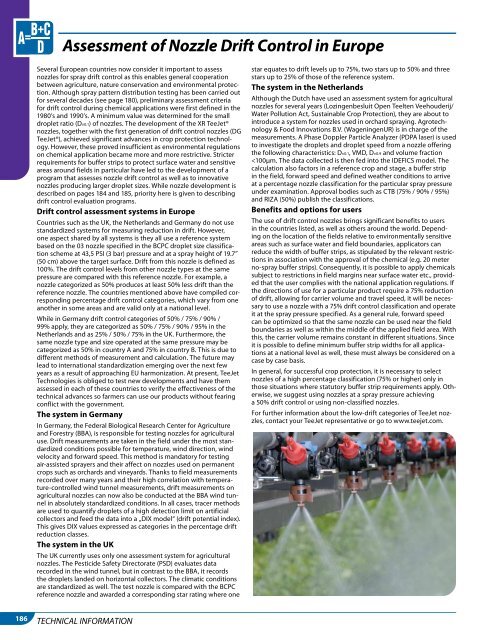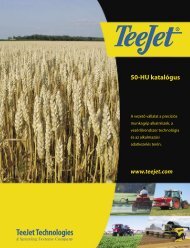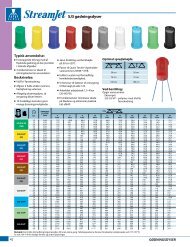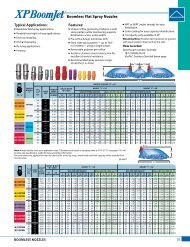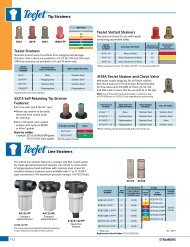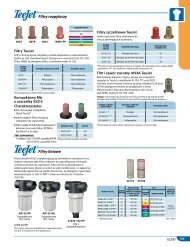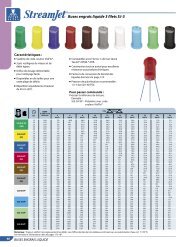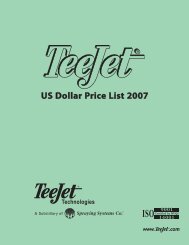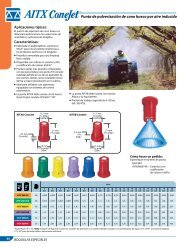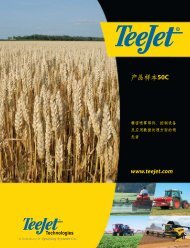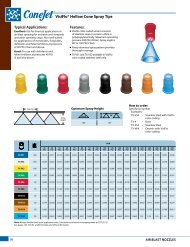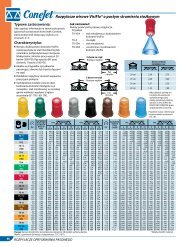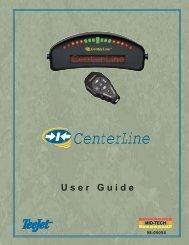Create successful ePaper yourself
Turn your PDF publications into a flip-book with our unique Google optimized e-Paper software.
Assessment of Nozzle Drift Control in EuropeSeveral European countries now consider it important to assessnozzles for spray drift control as this enables general cooperationbetween agriculture, nature conservation and environmental protection.Although spray pattern distribution testing has been carried outfor several decades (see page 180), preliminary assessment criteriafor drift control during chemical applications were first defined in the1980’s and 1990’s. A minimum value was determined for the smalldroplet ratio (Dv0.1) of nozzles. The development of the XR <strong>TeeJet</strong>®nozzles, together with the first generation of drift control nozzles (DG<strong>TeeJet</strong>®), achieved significant advances in crop protection technology.However, these proved insufficient as environmental regulationson chemical application became more and more restrictive. Stricterrequirements for buffer strips to protect surface water and sensitiveareas around fields in particular have led to the development of aprogram that assesses nozzle drift control as well as to innovativenozzles producing larger droplet sizes. While nozzle development isdescribed on pages 184 and 185, priority here is given to describingdrift control evaluation programs.Drift control assessment systems in EuropeCountries such as the UK, the Netherlands and Germany do not usestandardized systems for measuring reduction in drift. However,one aspect shared by all systems is they all use a reference systembased on the 03 nozzle specified in the BCPC droplet size classificationscheme at 43,5 PSI (3 bar) pressure and at a spray height of 19.79(50 cm) above the target surface. Drift from this nozzle is defined as100%. The drift control levels from other nozzle types at the samepressure are compared with this reference nozzle. For example, anozzle categorized as 50% produces at least 50% less drift than thereference nozzle. The countries mentioned above have compiled correspondingpercentage drift control categories, which vary from oneanother in some areas and are valid only at a national level.While in Germany drift control categories of 50% / 75% / 90% /99% apply, they are categorized as 50% / 75% / 90% / 95% in theNetherlands and as 25% / 50% / 75% in the UK. Furthermore, thesame nozzle type and size operated at the same pressure may becategorized as 50% in country A and 75% in country B. This is due todifferent methods of measurement and calculation. The future maylead to international standardization emerging over the next fewyears as a result of approaching EU harmonization. At present, <strong>TeeJet</strong>Technologies is obliged to test new developments and have themassessed in each of these countries to verify the effectiveness of thetechnical advances so farmers can use our products without fearingconflict with the government.The system in GermanyIn Germany, the Federal Biological <strong>Res</strong>earch Center for Agricultureand Forestry (BBA), is responsible for testing nozzles for agriculturaluse. Drift measurements are taken in the field under the most standardizedconditions possible for temperature, wind direction, windvelocity and forward speed. This method is mandatory for testingair-assisted sprayers and their affect on nozzles used on permanentcrops such as orchards and vineyards. Thanks to field measurementsrecorded over many years and their high correlation with temperature-controlledwind tunnel measurements, drift measurements onagricultural nozzles can now also be conducted at the BBA wind tunnelin absolutely standardized conditions. In all cases, tracer methodsare used to quantify droplets of a high detection limit on artificialcollectors and feed the data into a „DIX model“ (drift potential index).This gives DIX values expressed as categories in the percentage driftreduction classes.The system in the UKThe UK currently uses only one assessment system for agriculturalnozzles. The Pesticide Safety Directorate (PSD) evaluates datarecorded in the wind tunnel, but in contrast to the BBA, it recordsthe droplets landed on horizontal collectors. The climatic conditionsare standardized as well. The test nozzle is compared with the BCPCreference nozzle and awarded a corresponding star rating where onestar equates to drift levels up to 75%, two stars up to 50% and threestars up to 25% of those of the reference system.The system in the NetherlandsAlthough the Dutch have used an assessment system for agriculturalnozzles for several years (Lozingenbesluit Open Teelten Veehouderij/Water Pollution Act, Sustainable Crop Protection), they are about tointroduce a system for nozzles used in orchard spraying. Agrotechnology& Food Innovations B.V. (WageningenUR) is in charge of themeasurements. A Phase Doppler Particle Analyzer (PDPA laser) is usedto investigate the droplets and droplet speed from a nozzle offeringthe following characteristics: Dv0.1, VMD, Dv0.9 and volume fraction


